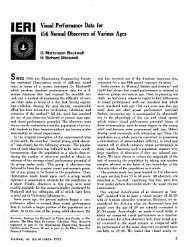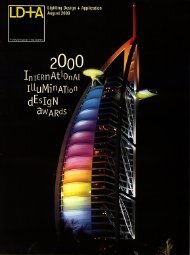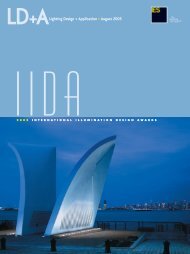faces of the future - Illuminating Engineering Society
faces of the future - Illuminating Engineering Society
faces of the future - Illuminating Engineering Society
Create successful ePaper yourself
Turn your PDF publications into a flip-book with our unique Google optimized e-Paper software.
TOOLS + TECHNIQUES<br />
Photo courtesy <strong>of</strong> Spring City<br />
Technology Takes <strong>the</strong> Scenic Route<br />
Ambler, PA, is a small town with big-city aspirations. With help from engineering firm Gilmore<br />
and Associates, it recently installed 22 new decorative LED luminaires from Spring City Electrical<br />
Manufacturing along Race Street and joined Cree’s LED City initiative (now <strong>the</strong> DOE’s Municipal Solid-<br />
State Street Lighting Consortium). Though it had previously used high-pressure sodium lights for<br />
street lighting, <strong>the</strong> Borough <strong>of</strong> Ambler decided to move in a new direction after receiving funds from<br />
<strong>the</strong> county to revitalize its streetscape.<br />
The first order <strong>of</strong> business was determining how<br />
to make LEDs work for a decorative street-lighting<br />
application. Unlike cobra-head LED streetlights, decorative<br />
LED streetlights are less common. “Decorative<br />
applications are a completely different animal than<br />
cobra-head applications,” says Spring City vice president<br />
<strong>of</strong> sales and marketing, Chris Rosfelder. “You not<br />
only want to light a street efficiently, you also want to<br />
create <strong>the</strong> right aes<strong>the</strong>tic atmosphere.”<br />
Ra<strong>the</strong>r than forcing <strong>the</strong> technology to fit into its<br />
existing fixtures, Spring City modified its luminaires<br />
to meet <strong>the</strong> needs <strong>of</strong> <strong>the</strong> LEDs. The Borough luminaires<br />
installed on Race Street are equipped with<br />
<strong>the</strong>rmal management technology that allows for longer<br />
life <strong>of</strong> <strong>the</strong> LED drivers and optical technology that<br />
utilizes a parabolic and elliptical reflector system.<br />
Fitted with 3,000K Cree LEDs, each luminaire uses 74<br />
watts, as opposed to <strong>the</strong> 150-W power draw <strong>of</strong> <strong>the</strong><br />
HPS fixtures typically used by <strong>the</strong> borough.<br />
RACE STRET DECORATIVE STREETLIGHTS,<br />
AMBLER, PA<br />
The luminaires also maintain an historic aes<strong>the</strong>tic<br />
The Challenge: Add LED streetlights without appeal. “The goal was to incorporate LED technology<br />
comprising <strong>the</strong> historic aes<strong>the</strong>tic <strong>of</strong> <strong>the</strong> streetscape without compromising <strong>the</strong> aes<strong>the</strong>tics <strong>of</strong> our design,”<br />
The Solution: Decorative luminaires with ro<strong>of</strong>mounted<br />
LEDs shield <strong>the</strong> light source<br />
says Rosfelder. “You don’t want a fixture that looks<br />
like it’s from 1910 or 1920, and <strong>the</strong>n have visible LEDs<br />
that look like Christmas tree lights.” To shield <strong>the</strong> LEDs from view, <strong>the</strong>y are mounted in <strong>the</strong> cast ro<strong>of</strong> <strong>of</strong><br />
<strong>the</strong> luminaires. “It’s a semi-cut<strong>of</strong>f, post-top application that prohibits <strong>the</strong> viewer from seeing multiple<br />
points <strong>of</strong> light,” says Rosfelder.<br />
Ambler’s new decorative LED luminaires are expected to save it 60 percent in energy costs and $15<br />
a year per fixture in maintenance costs, for approximately $100 in savings each year.<br />
Elizabeth Hall<br />
38 www.ies.org

















